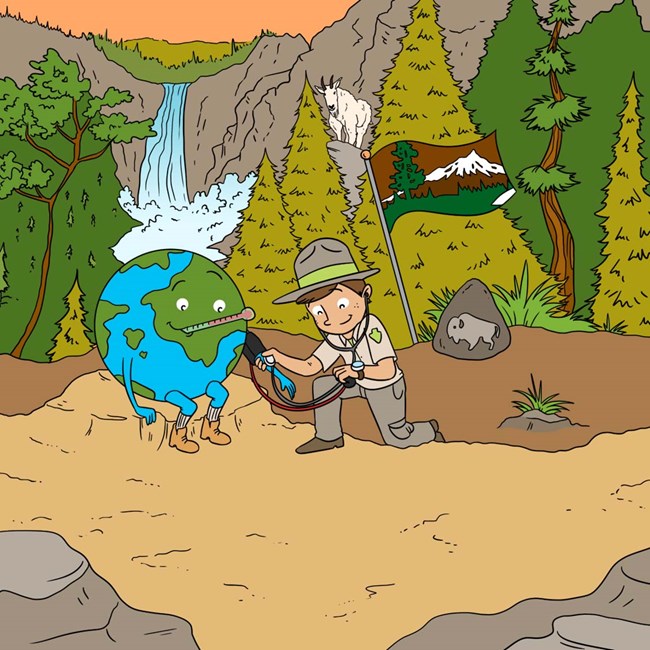
Credit: Frontiers for Young Minds
How do we know if parks are healthy? We measure their vital signs, of course! Across the country, there are 32 inventory and monitoring networks that measure the status and trends of all kinds of park resources. We're learning a lot after years of collecting data.
These articles are a part of a collection, or special issue, of Frontiers for Young Minds, an international online journal of science written for kids and involving kids in the review process. Taking the Pulse of U.S. National Parks presents what we are learning from years of monitoring plants and animals and physical conditions in parks. The articles featured here are results from Alaska parks.
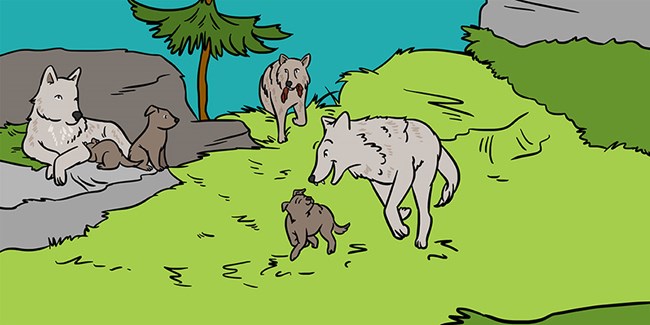
Frontiers for Young Minds
It Takes a Pack to Raise a Pup
Wolves are important to keep ecosystems healthy. For wolf populations to thrive, pups need to survive into adulthood. Wolf pups can be harmed, even killed, by wolves from outside their pack. To protect the pups, some wolves in the pack must stay at the den and guard the pups. But some of the adults must leave the den sometimes, to hunt for food and to keep other wolves out of the pack’s territory. By monitoring and studying wolves for many years across North America and in Alaska’s national parks, we are learning how wolves divide these tasks. We know that the mother wolves care for their pups for the first several weeks while nursing, but once the pups no longer need milk, all pack members share in taking care of the pups. We have come to understand that all wolves are important to the success of the pack.
Also see: monitoring wolves in central Alaska
Sorum, M., J. Pruszenski, and B. Borg. 2022. It takes a pack to raise a pup. Frontiers for Young Minds 10: 735160
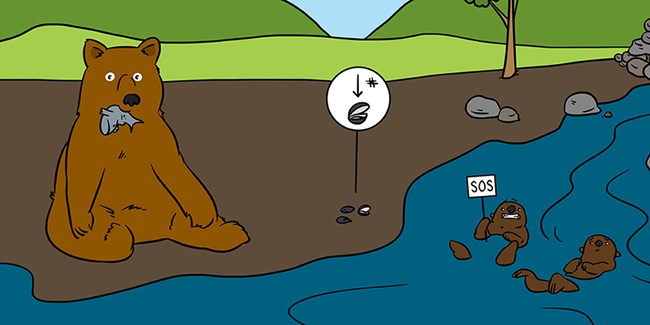
Credit: Frontiers for Young Minds
Where Land and Sea Meet: Brown Bears and Sea Otters
In Katmai National Park, Alaska, we have seen changes in the number of brown bears and sea otters. The number of animals of a species a habitat can support is called carrying capacity. Even though bears live on land and sea otters live in the ocean, these two mammals share coastal habitats. Bears eat salmon, other fish, plants, clams, and beached whales. Sea otters feed on clams and other marine invertebrates. All these foods are influenced by the ocean. Recently, we have seen fewer bears but more sea otters! What changed? Many things, but several observations point to the ocean. There are fewer salmon, whales, and clams, so bears rely more on plants for food. Fewer clams mean sea otters must work harder to find food. Our studies are helping us to understand how and why carrying capacity for a given species may change over time.
Also see: sea otters and brown bears in Southwest Alaska
Coletti, H., G. Hilderbrand, J. Bodkin, B. Bellachey, J. Erlenbach, G. Esslinger, M. Hannam, K. Kloecker, B. Mangipane, A. Miller, D. Monson, B. Pister, K. Griffin, K. Bodkin, and T. Smith. 2022. Where land and sea meet: Brown bears and sea otters. Frontiers for Young Minds 10: 715993.
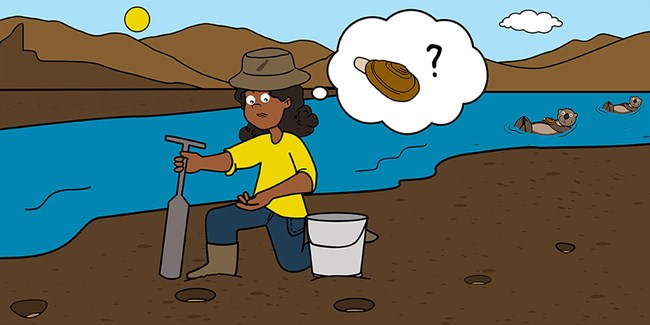
Credit: Frontiers for Young Minds
The Mysterious Case of the Missing Razor Clams
Oceans are changing and these changes are affecting the animals that live there. Animals respond differently to changes in water temperature, food availability, and contaminants. Those responses can be seen in their genes. A technique called transcriptomics allows scientists to see the response of an animal’s genes to its environment. We used transcriptomics to compare two populations of Pacific razor clams in Alaska (United States): one that has lots of clams and one that used to have lots but does not anymore. We were surprised when we did not find any differences in their gene responses! So, we had to think about what else might be influencing the number of clams in these two populations. As we “dug” for answers, we found out that there are differences between the populations that do not influence their genes but may impact their numbers, such as being eaten by predators.
Also see: marine intertidal invertebrates in Southwest Alaska
Coletti, H., L. Bowen, B. Ballachey, T. L. Wilson, S. Waters, M. Booz, K. L. Counihan, T. Hollmen, and B. Pister. 2022. The mysterious case of the missing razor clams. Frontiers for Young Minds 10: 715425.
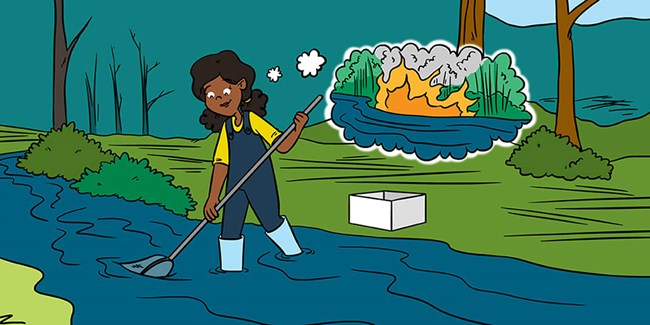
Frontiers for Young Minds
The weird and wonderful variety of bugs that live in streams is more than cool—it is a great scientific tool. The mixture of bugs helps scientists understand water quality, which means whether the water is clean or dirty. Two kinds of tools translate bug variety into measures of stream health. One is called a multimetric index; the other is called an observed-to-expected index. The multimetric index “speaks bug” to us. It uses bug preferences for food and habitat, tolerance for pollution, and other bug attributes to decipher whether a stream is to a bug’s liking. The observed-to-expected index uses scientists’ knowledge of which bugs usually occur in clean water, to predict which should be present in a good-quality stream. Both indices give us the big picture of water quality and help scientists track the health of streams in U.S. national parks.
Also see: Monitoring streams and rivers in central Alaska
Dinger, E. C., E. W. Schweiger, and T. Simmons. 2022. How healthy is a stream? Ask the stream bugs! Frontiers for young Minds 10: 716591.
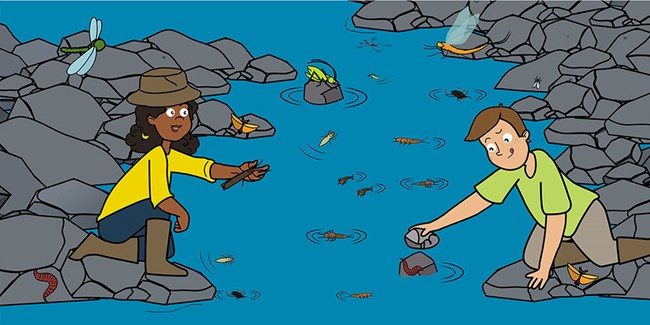
Frontiers for Young Minds
The Wild and Wonderful World of Stream Bugs
Under the surface of most streams a strange world exists, made up of hundreds of small critters called aquatic invertebrates. “Aquatic” means they live in the water and “invertebrate” means they have no backbones or even skeletons. Some have body parts that look like they came from an alien planet. Some have slippery bodies adapted to rushing stream water. These organisms play many important roles. Some live for up to 7 years and others live for as little as 2 weeks. Some eat slime growing on stream rocks and others eat leaves. Some, like the golden stonefly, even stalk and eat other invertebrates, like a tiger in a jungle. In national parks and around the world, scientists use these insects, worms, leeches, and mites to tell if the water is healthy. We can do this because certain stream invertebrates disappear if water is polluted, or if the stream habitat is degraded.
Also see: Monitoring streams and rivers in central Alaska
Simmons, T., E.C. Dinger, and E. W. Schweiger. 2022. The wild and wonderful world of stream bugs. Frontiers for Young Minds 10: 716573.

Frontiers for Young Minds
What's the Buzz About Native Bees?
Most plants depend on insects for pollination. Honey bees pollinate many of the foods people eat, but did you know that wild plants, and animals like birds and bears, also depend on pollinators? Native bees are the most diverse and efficient pollinators. Thousands of bee species transport pollen between plants in deserts, forests, mountains, meadows, and many other habitats. This service helps plants reproduce successfully, and the plants provide food and shelter for other animals. Bees are important for keeping our wild landscapes healthy. Scientists are discovering that climate change and other human-caused threats are changing bee populations. Therefore, it is important that we learn more about pollinators in wild places like national parks and that we support bees in our own backyards.
Also see: Marking a new bee-ginning: A new species of pollinator found in Denali National Park and Preserve
Rykken, J. 2022. What’s the buzz about native bees? Frontiers for Young Minds 10: 713108.
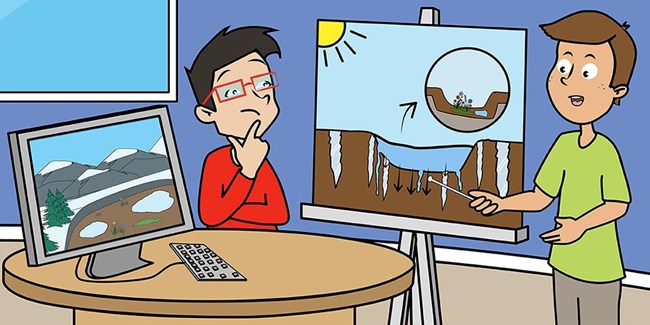
Credit: Frontiers for Young Minds
Permafrost and Draining Lakes in Arctic Alaska
In the Arctic, the ground is frozen most of the year. Only the top layer of soil thaws each summer. This frozen ground, called permafrost, contains a lot of frozen water (ice). There are many small lakes in the Arctic, in low spots formed from melted ice. But melting ice does not just create lakes, it can destroy them too. Melting permafrost can create gullies that let the water drain out of a lake. Most lakes in the Arctic are far from where people live, so we watch them using pictures taken from satellites. Recently, we have seen the water drain out of many lakes, which can affect plants and animals. We measure the number and size of drained lakes caused by thawing permafrost to understand how the Arctic is changing.
Also see: monitoring permafrost and lakes in the Arctic
Swanson, D. 2022. Permafrost and Draining Lakes in Arctic Alaska. Frontiers for Young Minds 10:692218. doi: 10.3389/frym.2022.692218

Credit: Frontiers for Young Minds
Fish Ear Stones Offer Climate Change Clues in Alaska Lakes
Otoliths, also known as ear stones, are small body parts that help fish with hearing and balance. Like tree rings, otoliths form one light and one dark band per year, creating rings. These rings can be measured to understand fish growth. The wider the ring, the greater the growth. In our study, we used otoliths to understand how one fish species—lake trout—responds to rising temperature in the state of Alaska. We found that warmer spring air temperature and earlier lake ice melt were related to faster lake trout growth. This finding is consistent with other studies that link warmer water temperature and earlier lake ice melt to increased plankton in Alaska’s lakes. Together, these findings suggest that climate-driven increases at the bottom of the food web might benefit top predators like lake trout. However, the relationship between warmer temperature and faster growth may not last.
Also see: water quality in Southwest Alaska parks
Bartz, K., V. von Biela, B. Black, D. Young, P. van der Sleen, and C. Zimmerman. 2022. Fish Ear Stones Offer Climate Change Clues In Alaska’s Lakes. Frontiers for Young Minds 10:726495.
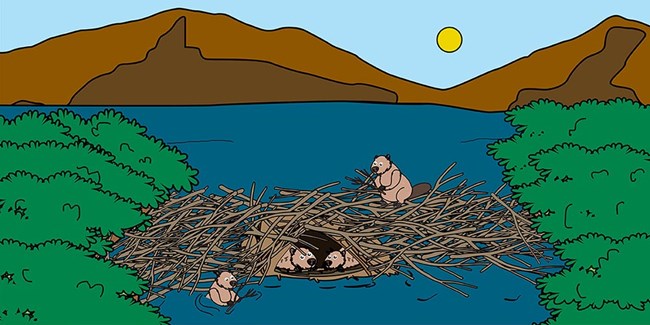
Credit: Frontiers for Young Minds
Beavers build dams that change the way water moves between streams, lakes, and the land. In Alaska, beavers are moving north from the forests into the Arctic tundra. When beavers build dams in the Arctic, they cause frozen soil, called permafrost, to thaw. Scientists are studying how beavers and the thawing of permafrost are impacting streams and rivers in Alaska’s national parks. For example, permafrost thaw from beavers can add harmful substances like mercury to streams. Mercury can be taken up by stream food webs, including fish, which then become unhealthy to eat. Permafrost thaw can also move carbon (from dead plants) to beaver ponds. When this carbon decomposes, it can be released from beaver ponds into the air as greenhouse gases, which cause Earth’s climate to warm. Scientists are trying to keep up with these busy beavers to better understand how they are changing Arctic landscapes and Earth’s climate.
Also see: monitoring streams and lakes in the Arctic
O’Donnell, J., M. Carey, B. Poulin, K. Tape, and J. Koch. 2022. How Beavers Are Changing Arctic Landscapes and Earth’s Climate. Frontiers for Young Minds 10:719051. doi: 10.3389/frym.2022.719051

Credit: Frontiers for Young Minds
A recipe for plant diversity in subarctic Alaska
Hungry for a little plant diversity? Let us mix some up! First, we gather available ingredients—a bit of soil, a few nutrients, and a selection of nearby plants. Then, we add them together, pour them onto a landscape and let our concoction sit. Sound easy enough? But wait… was that soil we used too acidic? Did we add enough liquid? Was our landscape flat or tilted? How can we adjust our recipe to grow the most plant species in one place? As plant ecologists, we travel to remote places in subarctic Alaska to look at which species grow there. At each place, we record the condition of the environment and tally the number of plant species we find. Over 1,000s of visits, we now have a pretty good recipe for cooking up plant diversity! By learning about where plant diversity is high now, we can help protect it into the future.
Also see: vegetation structure and composition monitoring in Central Alaska
Stehn, S. and C. Roland. 2022. A Recipe for Plant Diversity in Subarctic Alaska. Frontiers for Young Minds 10:703708. doi: 10.3389/frym.2022.703708
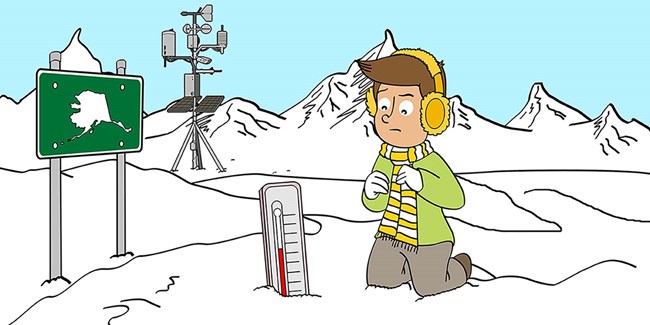
Credit: Frontiers for Young Minds
Two degrees matters
How do you tell if someone is not well? You take the person’s temperature. If it is too warm, something is not quite right. We care about how the weather and climate are changing in Alaska’s national parks, so we continuously take their temperatures. We have dozens of weather stations in remote locations in the northern Alaska parks that run continuously, powered by the sun. Over the past several years, we found that the air and ground temperatures have been warmer than normal. Plants, animals, and people get used to living in their environments. They thrive within an expected temperature range. Things get out of whack when the environment that organisms are accustomed to changes. In northern Alaska, warming of just a few degrees can cause ice to melt and formerly frozen ground to thaw. Once the ground thaws, the ice changes to water and the landscape changes.
Also see: climate monitoring in the Arctic, permafrost monitoring in the Arctic, climate monitoring in Central Alaska, permafrost monitoring in Central Alaska, climate monitoring in Southwest Alaska, climate monitoring in Southeast Alaska, high-latitude climate change
Hey teachers! Check out this lesson plan.
Sousanes, P., K. Hill, and D. Swanson. 2022. Two Degrees Matters. Frontiers for Young Minds 10:719108. doi: 10.3389/frym.2022.719108

Credit: Frontiers for Young Minds
The recovery of the American peregrine falcon in Alaska
American Peregrine Falcons nesting along Alaska’s upper Yukon River have been studied for nearly 50 years. Peregrine populations decreased in the 1960s because widespread use of the insecticide DDT caused their eggshells to thin. Thin eggshells meant that eggs crushed easily in the nest, which reduced the number of baby birds produced. Eventually, Peregrine Falcons were listed as endangered under the Endangered Species Act in the United States (U.S.). After the U.S. banned the use of DDT, the U.S. Fish and Wildlife Service, National Park Service, and others helped Peregrine Falcons recover. Today, upper Yukon River Peregrine Falcons have rebounded and are thriving. The Peregrine Falcon’s recovery in the U.S. is a shining success story of the Endangered Species Act, although climate change and other pollutants create continuing challenges for the species.
Also see: Peregrine Falcon monitoring in Central Alaska
Payer, D. and M. Flamme. 2022. The Recovery of the American Peregrine Falcon in Alaska. Frontiers for Young Minds 10:714834. doi: 10.3389/frym.2022.714834
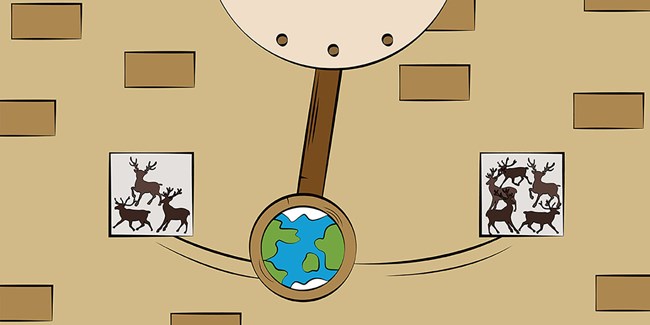
Credit: Frontiers for Young Minds
What goes up must come down: The influence of climate on caribou populations
Wildlife populations naturally go up and down. Oscillation is the term used for this pattern of highs (when there are many animals) and lows (when there are few). When the number of births is greater than the number of deaths, then populations grow. If deaths exceed births, populations decline. Caribou in the Arctic have dramatic population oscillations. The number of caribou can grow very high and also decrease to very few. Large-scale, long-lasting weather oscillations are one reason for this pattern. Knowledge of the connection between wildlife populations and climate oscillations is important to help conserve species like caribou and to better understand how climate change will impact wildlife.
Also see: monitoring caribou in the Arctic and in Central Alaska
Hey teachers! Check out this lesson plan.
Joly, K. 2021. What Goes Up Must Come Down: The Influence of Climate on Caribou Populations. Frontiers for Young Minds 9:631372. doi: 10.3389/frym.2021.631372
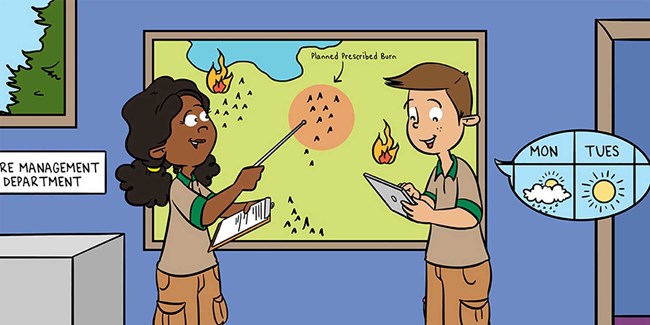
Credit: Frontiers for Young Minds
Rising from the Ashes: The role of fires in National Parks
Fire is a natural and healthy part of many ecosystems, and many plant species rely on it to reproduce. Some species require the actual heat and flames for their seeds to be released and sprout. Other species rely on fire to burn off dried needles and leaves on the ground as well as many of the shrubs and small trees. This opens up the forest and allows more space and light for small plants and trees. While fire is a good thing for many plants and ecosystems, this is not the case everywhere. In areas that get high amounts of rain, ecosystems are not adapted to fire. Human-caused fires in these places can be devastating to the plants there. It is the job of fire managers and ecologists to manage wildfires, make decisions about fire suppression, and decide if additional fires are needed in key ecosystems.
Also see: Fire extent and severity in the Arctic
Sanders, S., L. Mutch, M. Wasser, J. Barnes, and S. Perles. 2021. Rising From the Ashes: The Role of Fires in National Parks. Frontiers for Young Minds 9:627635. doi: 10.3389/frym.2021.627635
Last updated: April 23, 2024
